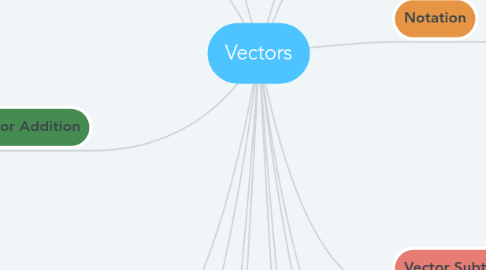Vectors
作者:Ethan Fotia


1. Components
1.1. A vector has two components known as the horizontal and vertical components. These components form a right angle.
2. Magnitude
2.1. The magnitude of the vector is the hypotenuse of the horizontal and vertical components. When given the horizontal and vertical components, the magnitude can be found by using the pathagoreon theorem.
2.2. Equations for 2-D and 2-D vectors
3. Vector Addition
3.1. The addition of two vectors is shown by u+v.
3.2. When adding vectors u+v, you simply add the horizontal components together and add the vertical components together
3.3. For example, u+v when u = <2,3> and v=<0,5>. u + v = <2+0,3+5>. u+v=<2,8>
3.4. Adding vectors u+v is interesting. To visualize it first draw vector u. Then, at the head of vector u, draw vector v. When adding v+u, the opposite occurs. This will form a parallelogram. The diagonal of this parallelogram will be both the actual vector of u+v and v+u
4. Scaler Multiplication
4.1. A vector can be manipulated by a scaler, c. c is always a constant. It is any real number.
4.2. v = <1,2> with scaler c=2. 2v = 2<1,2>. 2v= <2,4>. This specific scaler of positive 2 means that the vector, v, is twice as long and still headed in the same direction. A negative scaler would flip the vector in the other direction.
5. Dot Products
5.1. Dot products, u * v, between two vectors can be found using the following formula. If v = <v1,v2,v3> and u=<u1,u2,u3> then the dot product is u * v = u1*v1 + u2*v2 + u3*v3.
5.1.1. Dot products can be used to find the angle between two vectors. If we let theta be the angle between the two vectors we can use the following formula to solve for theta: cos(theta) = (u*v)/(||u||*||v||)
5.1.2. v and u are perpendicular if and only if u * v = 0
6. By: Ethan Fotia
7. Cross Products
7.1. The cross product is expressed as u x v. The solution to a cross product is a vector
7.2. u x v is only defined when u and v are vectors in R3
7.3. u x v is a vector with length (area of the parallelogram induced by u and v) and direction (the orthogonal to both u and v as defined by the right hand rule)
7.3.1. This is a picture of the right hand rule. In this picture, b is the direction of the cross product.
7.4. An important note is that cross products do not follow the cumulative property of multiplication.
7.5. To compute a cross product you want to draw u x v as a matrix with u and v being the rows and the three basis vectors as the column heads. Then rewrite the first two columns so the matrix is now 2 x 5. The, multiply along the diagonals left to right and add them up. Then, multiply along diagonals again right to left and multiply everything by -1. Then add the two expressions up to get your vector.
8. Planes
8.1. In R3 the equation for a plane is a(x-x1) +b(y-y1)+c(z-z1)=0. (x,y,z) is a point on the plane.
8.2. Cross Products can be used to find the equation of a plain that contains certain points. Look at the picture for an example
8.2.1. Example
8.3. An intersection of 2 planes can be represented by a parametric equation, r(t).
9. Definition
9.1. A vector is a mathematical object that represents both a direction and a length
10. Notation
10.1. A vector is represented by a boldface u and v
10.2. On a graph a vector is represented with a starting point, the tail, a line, whose length indicates its magnitude, and an arrow, known as the head, which indicates its direction.
10.2.1. Example
10.3. A vector can be written in coordinate form like so: v = <1, 2> where the first number represents the horizontal component and the second number represents the vertical component.
10.4. The magnitude of a vector is written as ||v|| or ||u||
11. Vector Subtraction
11.1. Vector subtraction is the same as vector addition. In the same manner, a parallelogram is formed with the diagonal representing u-v and v-u.
11.2. For example, u = <2,3> and v = <0,5>. u-v = <2-0,3-5>. u - v = <2,-2>
12. Unit Vectors
12.1. Unit vectors are any vectors with a length of 1 including basis vectors.
13. Basis Vectors
13.1. Basis vectors are represented by i, j and k. i = <1,0,0> or <1,0>. j = <0,1,0> or <0,1>. k = <0,0,1>
13.2. Basis vectors can be used with scalers. For example, v = ai +bj = <a,b>
14. Projections
14.1. A projection is when one vector is shaded onto another forming a right angle. It is better shown as a picture.
14.1.1. Picture
